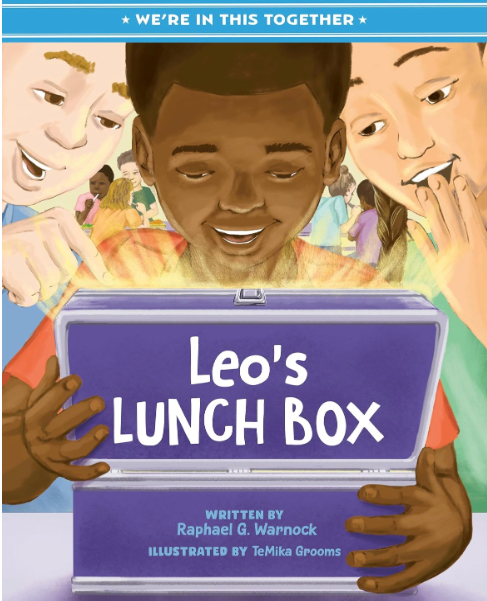The Contagion of Giving
We don’t usually review children’s books here at The Agitator. But today, we make an exception—not out of novelty, but necessity.
We’re All in This Together: Leo’s Lunchbox, a new picture book written by Senator Raphael Warnock and illustrated by TeMika Grooms, might seem like a simple tale for little ones: a boy shares his humble bologna sandwich and, as if by magic, the food multiplies. But what’s simple in form can be complex in meaning, and Warnock’s story—rooted in the parable of the loaves and fishes—offers a moral clarity the world right now needs a lot of.
 Warnock, the eleventh of twelve children, was raised in public housing in Savannah, Georgia, by parents who were both Pentecostal pastors. His father, a World War II veteran, made a living restoring junked cars, while his mother once picked cotton and tobacco in the fields of South Georgia. Their lives were steeped in faith, hard work, and a profound sense of community. These early experiences instilled in Warnock a deep understanding of scarcity and the transformative power of generosity.
Warnock, the eleventh of twelve children, was raised in public housing in Savannah, Georgia, by parents who were both Pentecostal pastors. His father, a World War II veteran, made a living restoring junked cars, while his mother once picked cotton and tobacco in the fields of South Georgia. Their lives were steeped in faith, hard work, and a profound sense of community. These early experiences instilled in Warnock a deep understanding of scarcity and the transformative power of generosity.
In Leo’s Lunchbox, Reverend/SenatorWarnock channels these formative lessons. The story follows Leo, a young boy who brings a bologna sandwich to school each day. One day, his lunch begins to multiply as he shares it with others, echoing the biblical miracle of the Feeding of the Five Thousand with the fishes and loaves. Through this narrative, Warnock emphasizes that generosity is not about abundance but about the willingness to share, even when you have little.
In a statement about the book, Senator Warnock says, “Leo’s Lunchbox is about the value and promise of communities coming together to care for one another.” He hopes the story will inspire young readers to share with those around them and to accept help when it comes
In this moment, when fundraising can feel like an arms race of data points and digital persuasion, we might do well to listen to Leo. Or better yet, to the child in ourselves that once believed kindness could change the world.
Senator Warnock, who grew up on bologna sandwiches in public housing, speaks not only from scripture but from memory. And he’s right: generosity is contagious. It always has been.
In ancient times, a widow dropped two copper coins into the temple treasury—everything she had. She gave not because it was strategic. She gave because it was right. That tiny act—the giving of the widow’s mite –still remembered two millennia later, lives on because it broke the rules of what we expect giving to look like.
Today, similar stories abound given just a quick search of the internet: 12-year-old Gabriel Clark began whittling wood to buy himself a bicycle. He ended up raising over $325,000 for Ukrainian children. And Kesz Valdez, a boy from the streets of Cavite in the Philippines, used his voice and pocket change to start an organization for other street children—eventually reaching more than 10,000.
Closer to home, an elderly couple in Houston, Mario and Diana De Los Santos, fill Easter baskets for kids waiting at a bus stop. They do it quietly, no camera crews, no nonprofit logos. Just baskets. Just joy. And there’s David Clarke over in Liverpool, who inherited £100,000 and gave it away—asking his neighbors how to spend it.
What do these stories have in common?
They are not large gifts touted in the press, or even smaller gifts whose sourcing is measured in lead conversion or ROI. They are acts. Unvarnished. Human. Sometimes even anonymous. They do not ask for recognition but offer themselves like a hand across a quiet neighborhood fence. Like an old woman reaching into a coin purse. Like a boy tearing his sandwich in two.
Fundraising, in its truest form, has always been more than money. It is the telling of stories—stories of what it meant to someone to be helped, and stories of what it meant to help.
Somewhere along the way, we’ve too often dressed generosity in metrics and disguised it in strategy. We’ve made it difficult when it is, in essence, an instinct.
Maybe it’s time to tell more stories like these. Stories that remind us that the human impulse to give is not rare, just rarely honored. This is why Kevin’s recent posts not only deal with what motivates people to give—but also with what stops them.
Because a contagion doesn’t spread through logic. It spreads through contact and through stories.
We all should be sharing stories of generosity with our donors and with each other. In troubling times like these more than ever each of us needs to share what we have—our food, our joy, our stories. Again, and again, and again. Until generosity is no longer the exception, but the rule.
Roger



Beautiful Roger thank you for this reminder that kindness and humanity is at the heart of all giving.
A heartwarming reminder of why nonprofits exist, the amazing work they do every day to support those in need, and the dramatic impact of financial gifts.